Public Health Report: Surgical Site Infections in Saudi Arabia
VerifiedAdded on 2023/06/03
|6
|1368
|166
Report
AI Summary
This report delves into the realm of public health, focusing on surgical site infections (SSIs) in Saudi Arabia. It begins with an introduction defining public health and its significance in minimizing health inequalities, emphasizing the role of health promotion and the importance of communication between organizations and the public. The report then presents a literature review, examining the prevalence and incidence of SSIs in Saudi Arabia, highlighting that the infections are more prevalent among older individuals, diabetics, and men. The study identifies various risk factors for SSIs, including modifiable factors such as weight and non-modifiable factors like gender. It also discusses the impact of obesity, malnutrition, tobacco use, and poor hygiene within healthcare settings. Finally, the report explores effective interventions for managing SSIs, such as screening patients for staph bacteria, providing preoperative education, and using appropriate antiseptic agents. The report aims to study the prevalence and incidence of surgical site infection in Saudi Arabia, identify the risk factors contributing to SSI, and find effective strategies for managing SSI in healthcare settings.
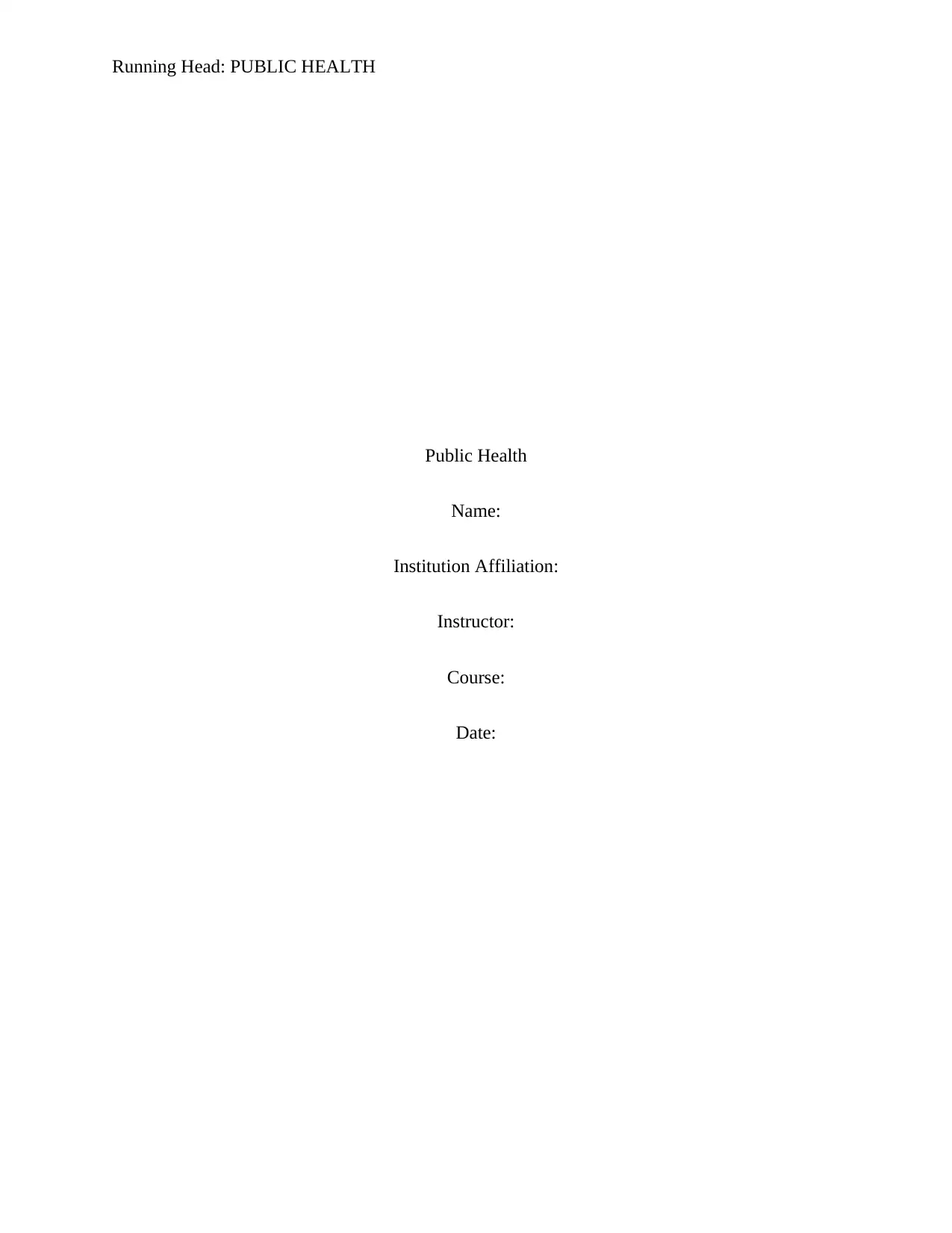
Running Head: PUBLIC HEALTH
Public Health
Name:
Institution Affiliation:
Instructor:
Course:
Date:
Public Health
Name:
Institution Affiliation:
Instructor:
Course:
Date:
Paraphrase This Document
Need a fresh take? Get an instant paraphrase of this document with our AI Paraphraser
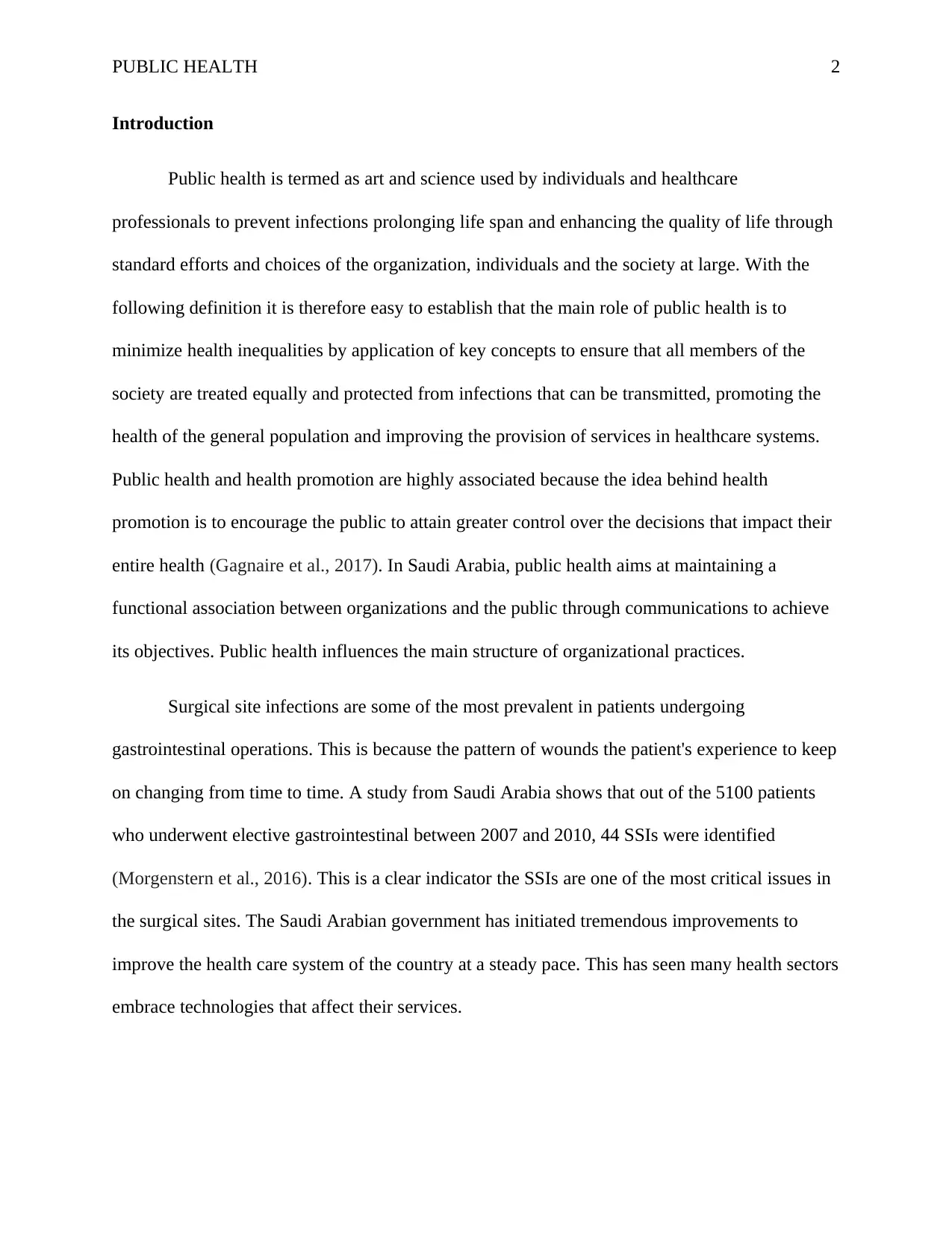
PUBLIC HEALTH 2
Introduction
Public health is termed as art and science used by individuals and healthcare
professionals to prevent infections prolonging life span and enhancing the quality of life through
standard efforts and choices of the organization, individuals and the society at large. With the
following definition it is therefore easy to establish that the main role of public health is to
minimize health inequalities by application of key concepts to ensure that all members of the
society are treated equally and protected from infections that can be transmitted, promoting the
health of the general population and improving the provision of services in healthcare systems.
Public health and health promotion are highly associated because the idea behind health
promotion is to encourage the public to attain greater control over the decisions that impact their
entire health (Gagnaire et al., 2017). In Saudi Arabia, public health aims at maintaining a
functional association between organizations and the public through communications to achieve
its objectives. Public health influences the main structure of organizational practices.
Surgical site infections are some of the most prevalent in patients undergoing
gastrointestinal operations. This is because the pattern of wounds the patient's experience to keep
on changing from time to time. A study from Saudi Arabia shows that out of the 5100 patients
who underwent elective gastrointestinal between 2007 and 2010, 44 SSIs were identified
(Morgenstern et al., 2016). This is a clear indicator the SSIs are one of the most critical issues in
the surgical sites. The Saudi Arabian government has initiated tremendous improvements to
improve the health care system of the country at a steady pace. This has seen many health sectors
embrace technologies that affect their services.
Introduction
Public health is termed as art and science used by individuals and healthcare
professionals to prevent infections prolonging life span and enhancing the quality of life through
standard efforts and choices of the organization, individuals and the society at large. With the
following definition it is therefore easy to establish that the main role of public health is to
minimize health inequalities by application of key concepts to ensure that all members of the
society are treated equally and protected from infections that can be transmitted, promoting the
health of the general population and improving the provision of services in healthcare systems.
Public health and health promotion are highly associated because the idea behind health
promotion is to encourage the public to attain greater control over the decisions that impact their
entire health (Gagnaire et al., 2017). In Saudi Arabia, public health aims at maintaining a
functional association between organizations and the public through communications to achieve
its objectives. Public health influences the main structure of organizational practices.
Surgical site infections are some of the most prevalent in patients undergoing
gastrointestinal operations. This is because the pattern of wounds the patient's experience to keep
on changing from time to time. A study from Saudi Arabia shows that out of the 5100 patients
who underwent elective gastrointestinal between 2007 and 2010, 44 SSIs were identified
(Morgenstern et al., 2016). This is a clear indicator the SSIs are one of the most critical issues in
the surgical sites. The Saudi Arabian government has initiated tremendous improvements to
improve the health care system of the country at a steady pace. This has seen many health sectors
embrace technologies that affect their services.
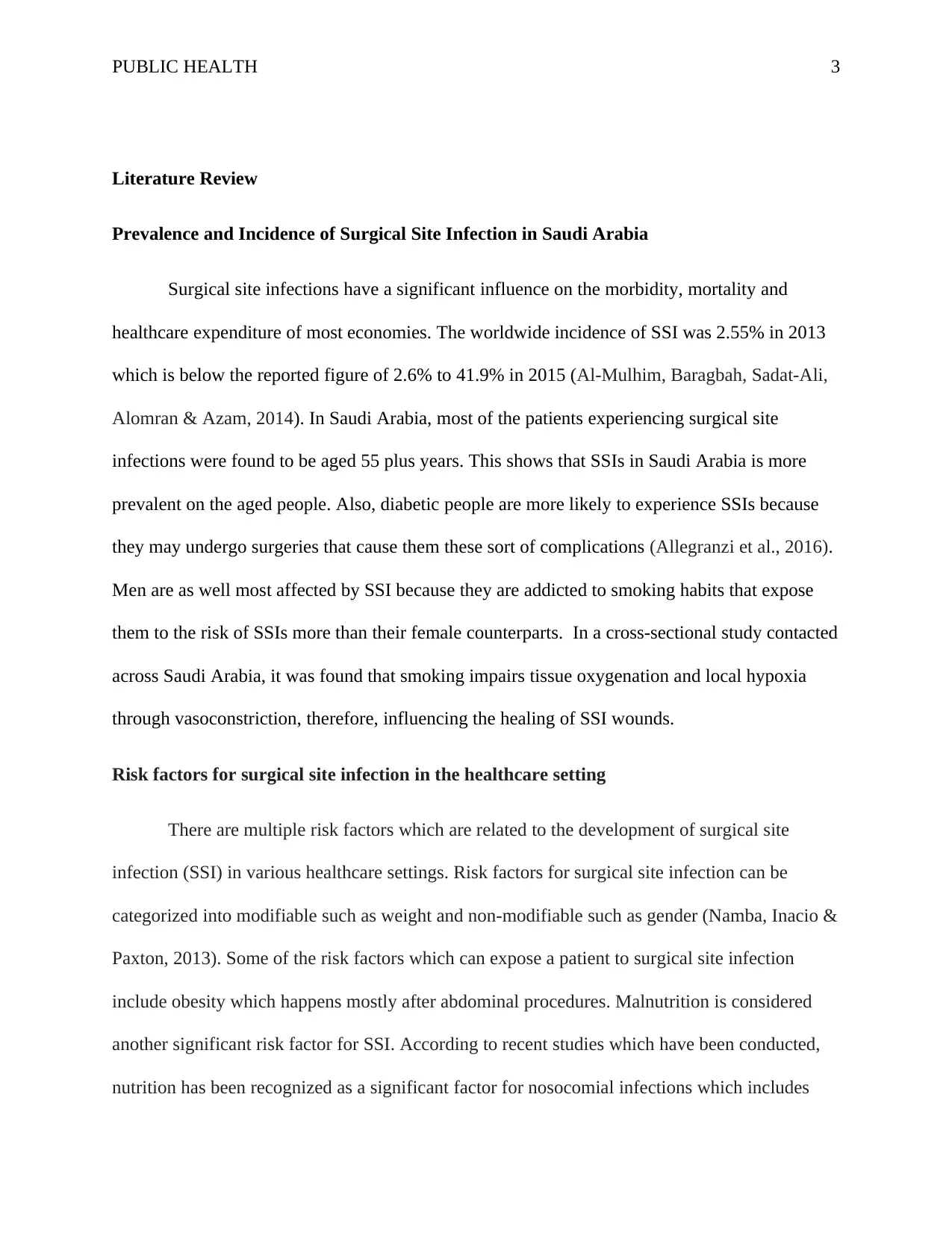
PUBLIC HEALTH 3
Literature Review
Prevalence and Incidence of Surgical Site Infection in Saudi Arabia
Surgical site infections have a significant influence on the morbidity, mortality and
healthcare expenditure of most economies. The worldwide incidence of SSI was 2.55% in 2013
which is below the reported figure of 2.6% to 41.9% in 2015 (Al-Mulhim, Baragbah, Sadat-Ali,
Alomran & Azam, 2014). In Saudi Arabia, most of the patients experiencing surgical site
infections were found to be aged 55 plus years. This shows that SSIs in Saudi Arabia is more
prevalent on the aged people. Also, diabetic people are more likely to experience SSIs because
they may undergo surgeries that cause them these sort of complications (Allegranzi et al., 2016).
Men are as well most affected by SSI because they are addicted to smoking habits that expose
them to the risk of SSIs more than their female counterparts. In a cross-sectional study contacted
across Saudi Arabia, it was found that smoking impairs tissue oxygenation and local hypoxia
through vasoconstriction, therefore, influencing the healing of SSI wounds.
Risk factors for surgical site infection in the healthcare setting
There are multiple risk factors which are related to the development of surgical site
infection (SSI) in various healthcare settings. Risk factors for surgical site infection can be
categorized into modifiable such as weight and non-modifiable such as gender (Namba, Inacio &
Paxton, 2013). Some of the risk factors which can expose a patient to surgical site infection
include obesity which happens mostly after abdominal procedures. Malnutrition is considered
another significant risk factor for SSI. According to recent studies which have been conducted,
nutrition has been recognized as a significant factor for nosocomial infections which includes
Literature Review
Prevalence and Incidence of Surgical Site Infection in Saudi Arabia
Surgical site infections have a significant influence on the morbidity, mortality and
healthcare expenditure of most economies. The worldwide incidence of SSI was 2.55% in 2013
which is below the reported figure of 2.6% to 41.9% in 2015 (Al-Mulhim, Baragbah, Sadat-Ali,
Alomran & Azam, 2014). In Saudi Arabia, most of the patients experiencing surgical site
infections were found to be aged 55 plus years. This shows that SSIs in Saudi Arabia is more
prevalent on the aged people. Also, diabetic people are more likely to experience SSIs because
they may undergo surgeries that cause them these sort of complications (Allegranzi et al., 2016).
Men are as well most affected by SSI because they are addicted to smoking habits that expose
them to the risk of SSIs more than their female counterparts. In a cross-sectional study contacted
across Saudi Arabia, it was found that smoking impairs tissue oxygenation and local hypoxia
through vasoconstriction, therefore, influencing the healing of SSI wounds.
Risk factors for surgical site infection in the healthcare setting
There are multiple risk factors which are related to the development of surgical site
infection (SSI) in various healthcare settings. Risk factors for surgical site infection can be
categorized into modifiable such as weight and non-modifiable such as gender (Namba, Inacio &
Paxton, 2013). Some of the risk factors which can expose a patient to surgical site infection
include obesity which happens mostly after abdominal procedures. Malnutrition is considered
another significant risk factor for SSI. According to recent studies which have been conducted,
nutrition has been recognized as a significant factor for nosocomial infections which includes
⊘ This is a preview!⊘
Do you want full access?
Subscribe today to unlock all pages.

Trusted by 1+ million students worldwide
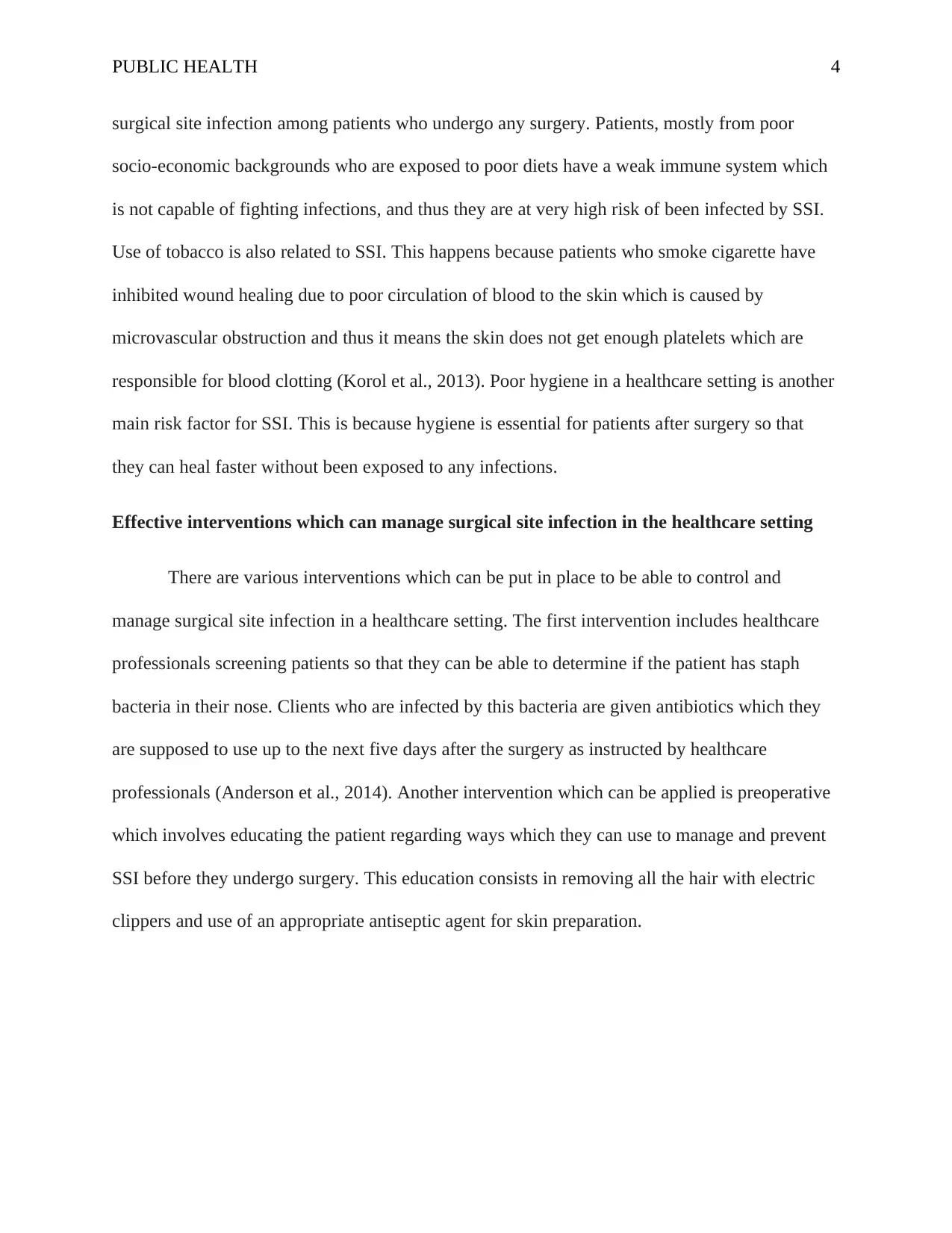
PUBLIC HEALTH 4
surgical site infection among patients who undergo any surgery. Patients, mostly from poor
socio-economic backgrounds who are exposed to poor diets have a weak immune system which
is not capable of fighting infections, and thus they are at very high risk of been infected by SSI.
Use of tobacco is also related to SSI. This happens because patients who smoke cigarette have
inhibited wound healing due to poor circulation of blood to the skin which is caused by
microvascular obstruction and thus it means the skin does not get enough platelets which are
responsible for blood clotting (Korol et al., 2013). Poor hygiene in a healthcare setting is another
main risk factor for SSI. This is because hygiene is essential for patients after surgery so that
they can heal faster without been exposed to any infections.
Effective interventions which can manage surgical site infection in the healthcare setting
There are various interventions which can be put in place to be able to control and
manage surgical site infection in a healthcare setting. The first intervention includes healthcare
professionals screening patients so that they can be able to determine if the patient has staph
bacteria in their nose. Clients who are infected by this bacteria are given antibiotics which they
are supposed to use up to the next five days after the surgery as instructed by healthcare
professionals (Anderson et al., 2014). Another intervention which can be applied is preoperative
which involves educating the patient regarding ways which they can use to manage and prevent
SSI before they undergo surgery. This education consists in removing all the hair with electric
clippers and use of an appropriate antiseptic agent for skin preparation.
surgical site infection among patients who undergo any surgery. Patients, mostly from poor
socio-economic backgrounds who are exposed to poor diets have a weak immune system which
is not capable of fighting infections, and thus they are at very high risk of been infected by SSI.
Use of tobacco is also related to SSI. This happens because patients who smoke cigarette have
inhibited wound healing due to poor circulation of blood to the skin which is caused by
microvascular obstruction and thus it means the skin does not get enough platelets which are
responsible for blood clotting (Korol et al., 2013). Poor hygiene in a healthcare setting is another
main risk factor for SSI. This is because hygiene is essential for patients after surgery so that
they can heal faster without been exposed to any infections.
Effective interventions which can manage surgical site infection in the healthcare setting
There are various interventions which can be put in place to be able to control and
manage surgical site infection in a healthcare setting. The first intervention includes healthcare
professionals screening patients so that they can be able to determine if the patient has staph
bacteria in their nose. Clients who are infected by this bacteria are given antibiotics which they
are supposed to use up to the next five days after the surgery as instructed by healthcare
professionals (Anderson et al., 2014). Another intervention which can be applied is preoperative
which involves educating the patient regarding ways which they can use to manage and prevent
SSI before they undergo surgery. This education consists in removing all the hair with electric
clippers and use of an appropriate antiseptic agent for skin preparation.
Paraphrase This Document
Need a fresh take? Get an instant paraphrase of this document with our AI Paraphraser
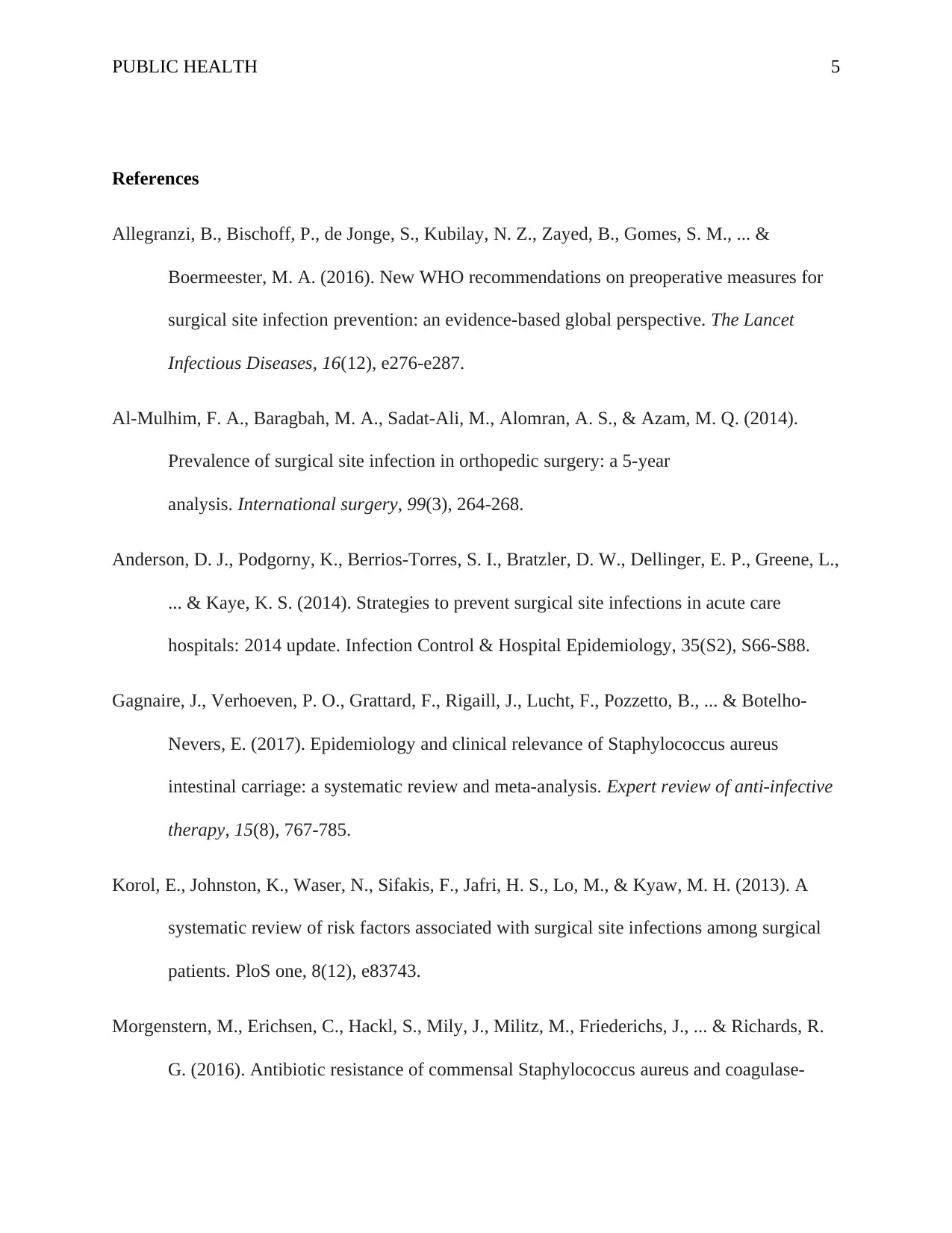
PUBLIC HEALTH 5
References
Allegranzi, B., Bischoff, P., de Jonge, S., Kubilay, N. Z., Zayed, B., Gomes, S. M., ... &
Boermeester, M. A. (2016). New WHO recommendations on preoperative measures for
surgical site infection prevention: an evidence-based global perspective. The Lancet
Infectious Diseases, 16(12), e276-e287.
Al-Mulhim, F. A., Baragbah, M. A., Sadat-Ali, M., Alomran, A. S., & Azam, M. Q. (2014).
Prevalence of surgical site infection in orthopedic surgery: a 5-year
analysis. International surgery, 99(3), 264-268.
Anderson, D. J., Podgorny, K., Berrios-Torres, S. I., Bratzler, D. W., Dellinger, E. P., Greene, L.,
... & Kaye, K. S. (2014). Strategies to prevent surgical site infections in acute care
hospitals: 2014 update. Infection Control & Hospital Epidemiology, 35(S2), S66-S88.
Gagnaire, J., Verhoeven, P. O., Grattard, F., Rigaill, J., Lucht, F., Pozzetto, B., ... & Botelho-
Nevers, E. (2017). Epidemiology and clinical relevance of Staphylococcus aureus
intestinal carriage: a systematic review and meta-analysis. Expert review of anti-infective
therapy, 15(8), 767-785.
Korol, E., Johnston, K., Waser, N., Sifakis, F., Jafri, H. S., Lo, M., & Kyaw, M. H. (2013). A
systematic review of risk factors associated with surgical site infections among surgical
patients. PloS one, 8(12), e83743.
Morgenstern, M., Erichsen, C., Hackl, S., Mily, J., Militz, M., Friederichs, J., ... & Richards, R.
G. (2016). Antibiotic resistance of commensal Staphylococcus aureus and coagulase-
References
Allegranzi, B., Bischoff, P., de Jonge, S., Kubilay, N. Z., Zayed, B., Gomes, S. M., ... &
Boermeester, M. A. (2016). New WHO recommendations on preoperative measures for
surgical site infection prevention: an evidence-based global perspective. The Lancet
Infectious Diseases, 16(12), e276-e287.
Al-Mulhim, F. A., Baragbah, M. A., Sadat-Ali, M., Alomran, A. S., & Azam, M. Q. (2014).
Prevalence of surgical site infection in orthopedic surgery: a 5-year
analysis. International surgery, 99(3), 264-268.
Anderson, D. J., Podgorny, K., Berrios-Torres, S. I., Bratzler, D. W., Dellinger, E. P., Greene, L.,
... & Kaye, K. S. (2014). Strategies to prevent surgical site infections in acute care
hospitals: 2014 update. Infection Control & Hospital Epidemiology, 35(S2), S66-S88.
Gagnaire, J., Verhoeven, P. O., Grattard, F., Rigaill, J., Lucht, F., Pozzetto, B., ... & Botelho-
Nevers, E. (2017). Epidemiology and clinical relevance of Staphylococcus aureus
intestinal carriage: a systematic review and meta-analysis. Expert review of anti-infective
therapy, 15(8), 767-785.
Korol, E., Johnston, K., Waser, N., Sifakis, F., Jafri, H. S., Lo, M., & Kyaw, M. H. (2013). A
systematic review of risk factors associated with surgical site infections among surgical
patients. PloS one, 8(12), e83743.
Morgenstern, M., Erichsen, C., Hackl, S., Mily, J., Militz, M., Friederichs, J., ... & Richards, R.
G. (2016). Antibiotic resistance of commensal Staphylococcus aureus and coagulase-
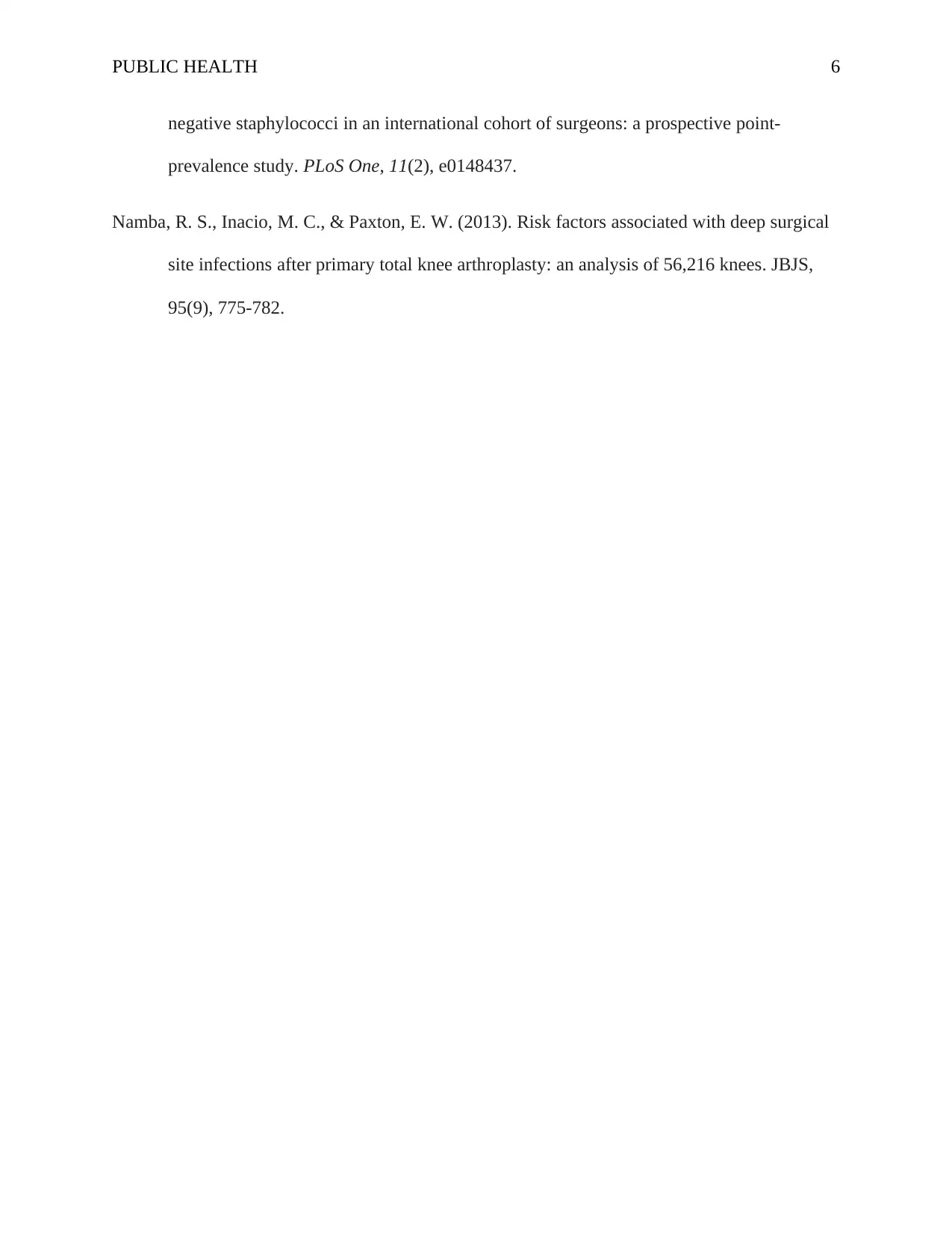
PUBLIC HEALTH 6
negative staphylococci in an international cohort of surgeons: a prospective point-
prevalence study. PLoS One, 11(2), e0148437.
Namba, R. S., Inacio, M. C., & Paxton, E. W. (2013). Risk factors associated with deep surgical
site infections after primary total knee arthroplasty: an analysis of 56,216 knees. JBJS,
95(9), 775-782.
negative staphylococci in an international cohort of surgeons: a prospective point-
prevalence study. PLoS One, 11(2), e0148437.
Namba, R. S., Inacio, M. C., & Paxton, E. W. (2013). Risk factors associated with deep surgical
site infections after primary total knee arthroplasty: an analysis of 56,216 knees. JBJS,
95(9), 775-782.
⊘ This is a preview!⊘
Do you want full access?
Subscribe today to unlock all pages.

Trusted by 1+ million students worldwide
1 out of 6
Related Documents
Your All-in-One AI-Powered Toolkit for Academic Success.
+13062052269
info@desklib.com
Available 24*7 on WhatsApp / Email
![[object Object]](/_next/static/media/star-bottom.7253800d.svg)
Unlock your academic potential
Copyright © 2020–2025 A2Z Services. All Rights Reserved. Developed and managed by ZUCOL.




